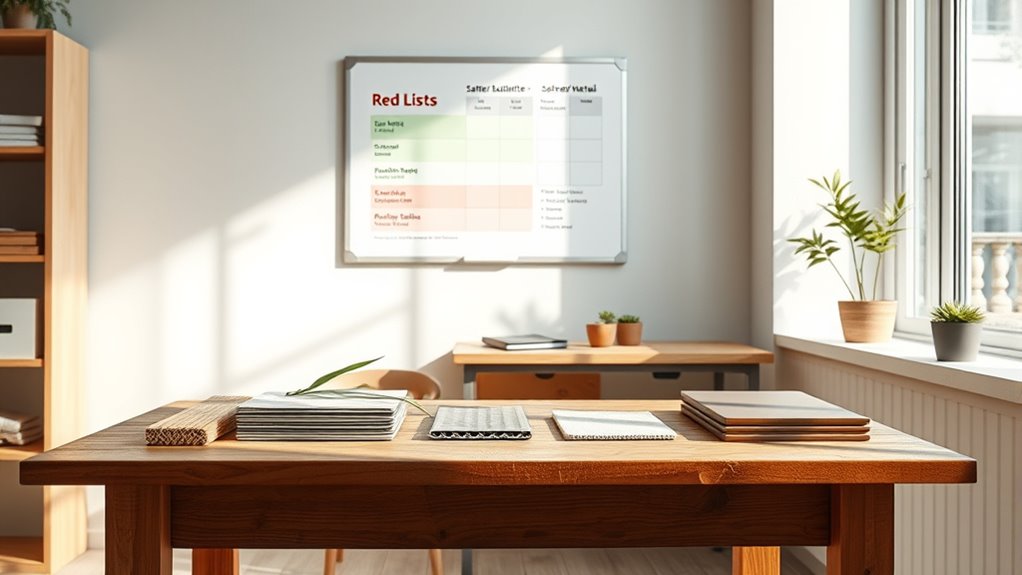To choose healthy materials, you should avoid substances on red lists that are known to be hazardous, such as certain chemicals in paints, adhesives, and furniture. Opt for safer, low-toxicity alternatives sourced responsibly and free from harmful chemicals. This helps improve indoor air quality and protects your health. Staying informed about red lists and safer substitutes empowers you to make better choices for healthier living environments. Keep exploring to discover more ways to create safer spaces.
Key Takeaways
- Red lists identify hazardous chemicals to avoid in building and consumer products, promoting safer material choices.
- Safer substitutes are available for red-listed substances, reducing health risks in indoor environments.
- Recognizing red-listed chemicals helps consumers and manufacturers select low-VOC and non-toxic materials.
- Using red list-free products supports sustainable sourcing and minimizes environmental and health impacts.
- Staying informed about red lists guides proactive decisions toward healthier, eco-friendly materials.

Have you ever wondered if the materials in your home could be affecting your health? Many everyday products contain chemicals that can pose health risks over time. To make smarter choices, you need to understand how to identify healthier options through toxicity reduction and sustainable sourcing. Choosing materials with these qualities helps create a safer environment for you and your loved ones while also supporting environmentally responsible practices.
Toxicity reduction is a key step in selecting healthy materials. It involves avoiding substances known to release harmful chemicals into the air or leach into your surroundings. For example, many conventional paints, adhesives, and furniture contain volatile organic compounds (VOCs) that can cause respiratory issues, headaches, or even long-term health problems. By opting for low-VOC or VOC-free products, you considerably reduce your exposure to these toxins. This conscious decision not only benefits your health but also pushes manufacturers to develop safer alternatives, encouraging a shift toward cleaner, healthier materials.
Sustainable sourcing plays an equally essential role in making healthier choices. When materials are sustainably sourced, they come from sources that prioritize environmental health, social responsibility, and resource conservation. This means choosing products made from renewable, responsibly harvested, or recycled materials. For instance, selecting FSC-certified wood ensures that the timber was harvested in a way that maintains forest health and biodiversity. Sustainable sourcing reduces the environmental footprint of manufacturing processes and minimizes the risk of supporting practices that harm ecosystems or exploit workers. It also often aligns with the use of safer, non-toxic materials, creating a more holistic approach to health and sustainability.
The concept of red lists is also essential here. Red lists identify substances that are considered hazardous and should be avoided in building materials and consumer products. These lists help you quickly recognize which chemicals or materials pose considerable health risks. By scrutinizing product labels and opting for items that are free from red-listed chemicals, you actively participate in toxicity reduction efforts. Many manufacturers now offer products that are explicitly free from these hazardous substances, making it easier for you to choose safer options without sacrificing quality or durability.
Additionally, staying informed about ongoing advances in AI in Education can help you better understand and advocate for safer, healthier choices in the marketplace. By prioritizing these principles, you create a ripple effect. When you prioritize toxicity reduction and sustainable sourcing, you influence the market to produce safer, more environmentally friendly materials. This proactive approach ultimately leads to healthier indoor environments, reduces your exposure to toxic chemicals, and supports a more sustainable future. Being informed and intentional about the materials you bring into your home empowers you to make choices that protect your health and the planet.
Frequently Asked Questions
How Are Red Lists Updated Over Time?
You can see red lists updated over time through ongoing chemical testing and regulatory updates. As new research emerges and regulations change, organizations review and revise these lists to reflect current safety standards. By staying informed about regulatory developments and incorporating recent chemical testing results, they guarantee the red lists remain accurate and effective in promoting healthier material choices for everyone.
What Criteria Define a “Safer” Substitute?
A safer substitute meets strict chemical regulations and earns recognized material certifications, ensuring it’s less toxic and environmentally friendly. You should look for alternatives that avoid hazardous chemicals listed on red lists, and that have third-party certifications like GreenGuard or Cradle to Cradle. These criteria help verify that the substitute is safer for human health and the environment, making it a responsible choice for sustainable materials.
Are There Certifications for Non-Toxic Building Materials?
Think of certifications like a lighthouse guiding you through foggy waters of greenwashing claims. Yes, there are certifications for non-toxic building materials, such as Green Guard and Cradle to Cradle, which signal manufacturer transparency. These labels help you distinguish genuinely safer options from misleading claims. Trust these certifications to illuminate your path, ensuring your building choices support health and sustainability rather than just marketing hype.
How Can Consumers Verify Material Safety Claims?
You can verify material safety claims by looking for transparent labels and certifications that emphasize material transparency. Research brands that prioritize consumer advocacy and disclose ingredient lists openly. Check for third-party verifications like Green Seal or Cradle to Cradle, which validate safer alternatives. Don’t hesitate to ask manufacturers directly about their sourcing and testing processes, ensuring they genuinely prioritize non-toxic, healthy materials for your space.
What Challenges Exist in Replacing Hazardous Materials?
Imagine replacing a hazardous chemical in a manufacturing process, only to discover it creates hazardous waste later. Challenges include understanding the entire material lifecycle, ensuring substitutes are truly safer, and avoiding unintended consequences. You might find a safer alternative, but it could be costly or less effective. Balancing safety, cost, and environmental impact makes replacing hazardous materials complex, requiring thorough research and careful decision-making to truly improve health and sustainability.
Conclusion
By choosing healthy materials and safer substitutes, you’re planting seeds for a healthier future. Think of these choices as a lighthouse guiding your home through foggy waters—illuminating the path toward safer, more sustainable living. Every decision you make acts as a beam of light, dispelling hidden toxins and paving the way for a brighter, cleaner environment. Your commitment is the beacon that guarantees a safe haven for yourself and generations to come.










